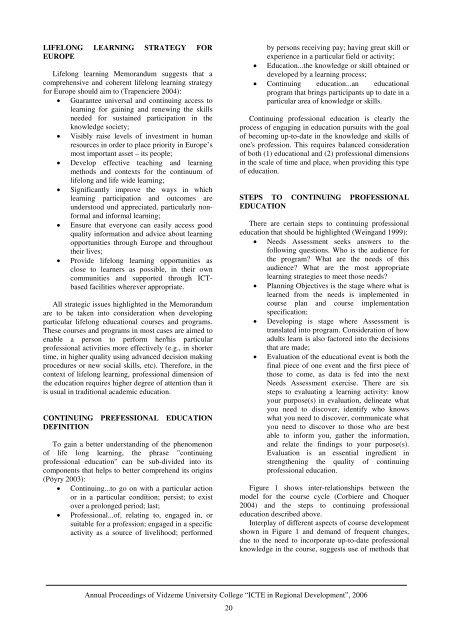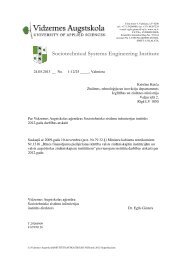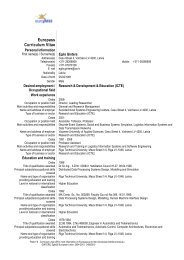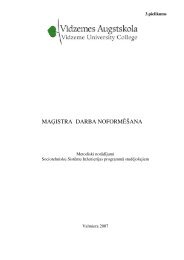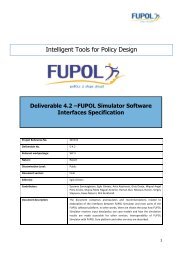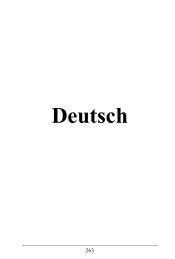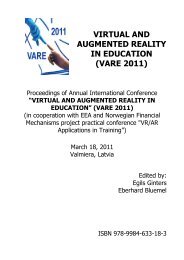Proceedings in pdf format. - Sociotechnical Systems Engineering ...
Proceedings in pdf format. - Sociotechnical Systems Engineering ...
Proceedings in pdf format. - Sociotechnical Systems Engineering ...
You also want an ePaper? Increase the reach of your titles
YUMPU automatically turns print PDFs into web optimized ePapers that Google loves.
LIFELONG LEARNING STRATEGY FOREUROPELifelong learn<strong>in</strong>g Memorandum suggests that acomprehensive and coherent lifelong learn<strong>in</strong>g strategyfor Europe should aim to (Trapenciere 2004):• Guarantee universal and cont<strong>in</strong>u<strong>in</strong>g access tolearn<strong>in</strong>g for ga<strong>in</strong><strong>in</strong>g and renew<strong>in</strong>g the skillsneeded for susta<strong>in</strong>ed participation <strong>in</strong> theknowledge society;• Visibly raise levels of <strong>in</strong>vestment <strong>in</strong> humanresources <strong>in</strong> order to place priority <strong>in</strong> Europe’smost important asset – its people;• Develop effective teach<strong>in</strong>g and learn<strong>in</strong>gmethods and contexts for the cont<strong>in</strong>uum oflifelong and life wide learn<strong>in</strong>g;• Significantly improve the ways <strong>in</strong> whichlearn<strong>in</strong>g participation and outcomes areunderstood und appreciated, particularly nonformaland <strong>in</strong>formal learn<strong>in</strong>g;• Ensure that everyone can easily access goodquality <strong>in</strong><strong>format</strong>ion and advice about learn<strong>in</strong>gopportunities through Europe and throughouttheir lives;• Provide lifelong learn<strong>in</strong>g opportunities asclose to learners as possible, <strong>in</strong> their owncommunities and supported through ICTbasedfacilities wherever appropriate.All strategic issues highlighted <strong>in</strong> the Memorandumare to be taken <strong>in</strong>to consideration when develop<strong>in</strong>gparticular lifelong educational courses and programs.These courses and programs <strong>in</strong> most cases are aimed toenable a person to perform her/his particularprofessional activities more effectively (e.g., <strong>in</strong> shortertime, <strong>in</strong> higher quality us<strong>in</strong>g advanced decision mak<strong>in</strong>gprocedures or new social skills, etc). Therefore, <strong>in</strong> thecontext of lifelong learn<strong>in</strong>g, professional dimension ofthe education requires higher degree of attention than itis usual <strong>in</strong> traditional academic education.CONTINUING PREFESSIONAL EDUCATIONDEFINITIONTo ga<strong>in</strong> a better understand<strong>in</strong>g of the phenomenonof life long learn<strong>in</strong>g, the phrase "cont<strong>in</strong>u<strong>in</strong>gprofessional education" can be sub-divided <strong>in</strong>to itscomponents that helps to better comprehend its orig<strong>in</strong>s(Pöyry 2003):• Cont<strong>in</strong>u<strong>in</strong>g...to go on with a particular actionor <strong>in</strong> a particular condition; persist; to existover a prolonged period; last;• Professional...of, relat<strong>in</strong>g to, engaged <strong>in</strong>, orsuitable for a profession; engaged <strong>in</strong> a specificactivity as a source of livelihood; performedby persons receiv<strong>in</strong>g pay; hav<strong>in</strong>g great skill orexperience <strong>in</strong> a particular field or activity;• Education...the knowledge or skill obta<strong>in</strong>ed ordeveloped by a learn<strong>in</strong>g process;• Cont<strong>in</strong>u<strong>in</strong>g education...an educationalprogram that br<strong>in</strong>gs participants up to date <strong>in</strong> aparticular area of knowledge or skills.Cont<strong>in</strong>u<strong>in</strong>g professional education is clearly theprocess of engag<strong>in</strong>g <strong>in</strong> education pursuits with the goalof becom<strong>in</strong>g up-to-date <strong>in</strong> the knowledge and skills ofone's profession. This requires balanced considerationof both (1) educational and (2) professional dimensions<strong>in</strong> the scale of time and place, when provid<strong>in</strong>g this typeof education.STEPS TO CONTINUING PROFESSIONALEDUCATIONThere are certa<strong>in</strong> steps to cont<strong>in</strong>u<strong>in</strong>g professionaleducation that should be highlighted (We<strong>in</strong>gand 1999):• Needs Assessment seeks answers to thefollow<strong>in</strong>g questions. Who is the audience forthe program? What are the needs of thisaudience? What are the most appropriatelearn<strong>in</strong>g strategies to meet those needs?• Plann<strong>in</strong>g Objectives is the stage where what islearned from the needs is implemented <strong>in</strong>course plan and course implementationspecification;• Develop<strong>in</strong>g is stage where Assessment istranslated <strong>in</strong>to program. Consideration of howadults learn is also factored <strong>in</strong>to the decisionsthat are made;• Evaluation of the educational event is both thef<strong>in</strong>al piece of one event and the first piece ofthose to come, as data is fed <strong>in</strong>to the nextNeeds Assessment exercise. There are sixsteps to evaluat<strong>in</strong>g a learn<strong>in</strong>g activity: knowyour purpose(s) <strong>in</strong> evaluation, del<strong>in</strong>eate whatyou need to discover, identify who knowswhat you need to discover, communicate whatyou need to discover to those who are bestable to <strong>in</strong>form you, gather the <strong>in</strong><strong>format</strong>ion,and relate the f<strong>in</strong>d<strong>in</strong>gs to your purpose(s).Evaluation is an essential <strong>in</strong>gredient <strong>in</strong>strengthen<strong>in</strong>g the quality of cont<strong>in</strong>u<strong>in</strong>gprofessional education.Figure 1 shows <strong>in</strong>ter-relationships between themodel for the course cycle (Corbiere and Choquer2004) and the steps to cont<strong>in</strong>u<strong>in</strong>g professionaleducation described above.Interplay of different aspects of course developmentshown <strong>in</strong> Figure 1 and demand of frequent changes,due to the need to <strong>in</strong>corporate up-to-date professionalknowledge <strong>in</strong> the course, suggests use of methods thatAnnual <strong>Proceed<strong>in</strong>gs</strong> of Vidzeme University College “ICTE <strong>in</strong> Regional Development”, 200620


